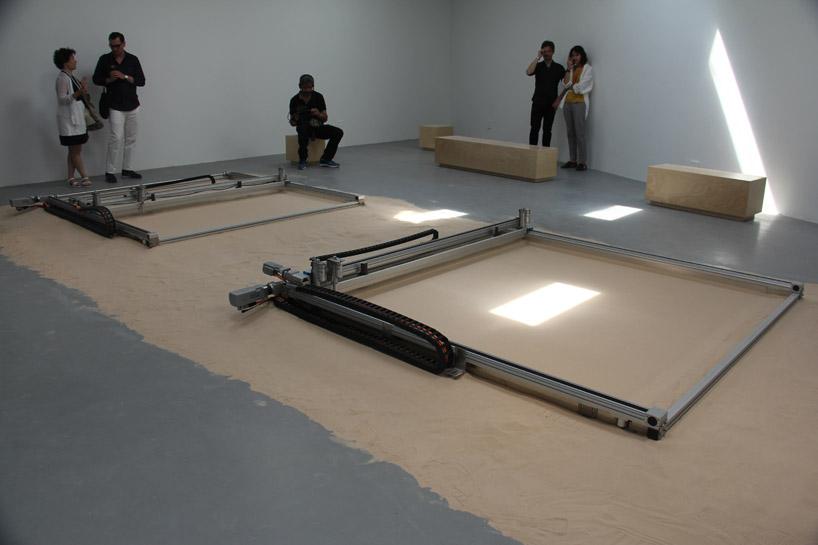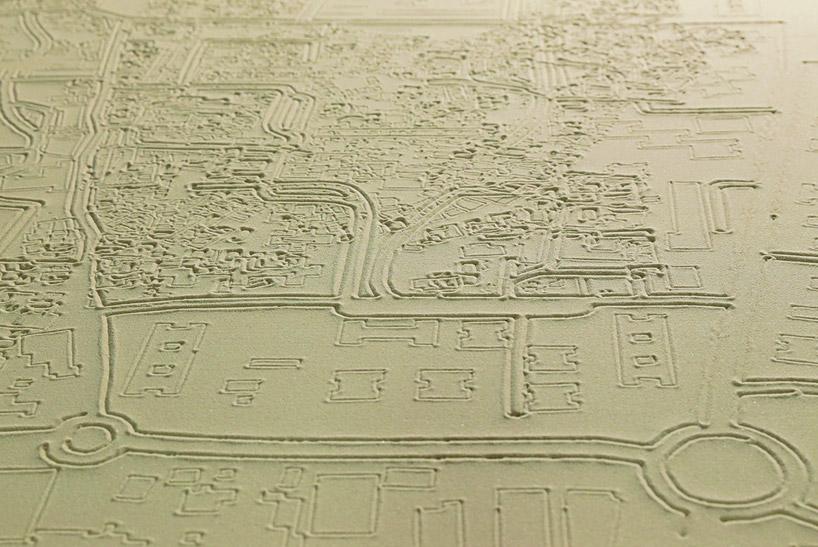 Curators Ori Scialom, Roy Brand, Keren Yeala-Golan, and Edith Kofsky, have turned the Israeli Pavilion at the Venice Architecture Biennale into a sandy construction site. Rather than building up in plastic or molding in clay, they are printing, and reprinting, the history of Israeli land use in sand. The term they have coined to describe the urban planning and development in Israel is ‘urburb.’ This is meant to convey the neither urban nor suburban nature of the development that is both sprawling and dense at the same time.
Curators Ori Scialom, Roy Brand, Keren Yeala-Golan, and Edith Kofsky, have turned the Israeli Pavilion at the Venice Architecture Biennale into a sandy construction site. Rather than building up in plastic or molding in clay, they are printing, and reprinting, the history of Israeli land use in sand. The term they have coined to describe the urban planning and development in Israel is ‘urburb.’ This is meant to convey the neither urban nor suburban nature of the development that is both sprawling and dense at the same time.
There are four sand canvases being articulated by the printers that make the drawings by carving through the soft sand with a scribe. The Cartesian views of Israeli land and urban development that are printed, reflect the past century of Modernist building in the country. The drawings are created on four different scales, one assigned to each machine. The first machine is dedicated to the national scale, and it continuously draws out the way in which new towns and settlements were created or changed over the 100-year period. A second machine prints the ways in which different cities were built up over that period. The third operates at the level of the neighborhood, and the fourth creates images of individual buildings.
The technique of sand printing is particularly appropriate because of the way the media can continually be reshaped, the malleability of the sand in the face of the metal scribe, and the top down nature of the creation, both in terms of planning and in viewing. The carvings are made and then erased and then made again; a reference to the blank slate approach often taken in Israeli architecture.
Music plays in the background, emphasizing the relentless and rhythmic shaping and reshaping of the soft sand. The repetition and automation resembles the more unimaginative architecture of sameness, home to 80% of the population of Israel, and which Yelea-Golan has dubbed ‘Boring Architecture’. She discusses the existence of this project as an obvious critique of much of Israeli development discourse, that has portrayed Israel as being built up where nothing existed. Each time the printer erases all of its history to start overlaying anew, it is at the junction between ancient desert sands and modern automation, that allows for no impact from what came before.
Then, of course, there is also a message of the impermanence of all things, the brutality of mechanized oppression, and the question of how to move forward without simply undoing. Offering the answer to any of the questions that the exhibit raises, is beyond the scope and power of either the display or the curators. However, it is an important piece of self-exploration made possible by the very advances in The Modern, that can be either aides to, or weapons against, humanizing mark-making in the built environment.
What do you think about these artful representations, using a type of 3D printing that isn’t meant to last? Although the printers only print on a plain, the resulting prints are somewhat three dimensional. Discuss in the Sand Printing thread on 3DPB.com
Subscribe to Our Email Newsletter
Stay up-to-date on all the latest news from the 3D printing industry and receive information and offers from third party vendors.
You May Also Like
Further Understanding of 3D Printing Design at ADDITIV Design World
ADDITIV is back once again! This time, the virtual platform for additive manufacturing will be holding the first-ever edition of ADDITIV Design World on May 23rd from 9:00 AM –...
3D Printer Maker EVO-tech Reborn as NEVO3D — Once More With Feeling
EVO-tech was a 3D printing service and original equipment manufacturer established in 2013 and based in Schörfling am Attersee, Austria. The company produced high-quality material extrusion systems featuring linear bearings,...
3D Systems Brings 3D Printed PEEK Cranial Implant to the U.S. with FDA Clearance
For more than 10 years, 3D Systems (NYSE:DDD) has worked hand-in-hand with surgeons to plan over 150,000 patient-specific cases, and develop more than two million instruments and implants from its...
CDFAM Returns to Berlin for Second Annual Symposium
The second CDFAM Computational Design Symposium is scheduled for May 7-8, 2024, in Berlin, and will convene leading experts in computational design across all scales. Building upon the first event...

































